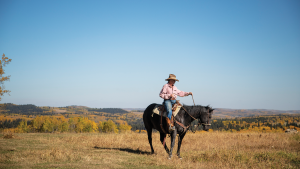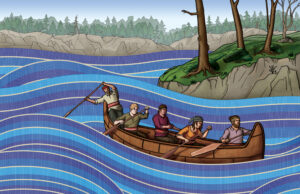The last thing I wanted to do after a day digging at the Bodo Archaeological Centre and Dig Site in east-central Alberta was read a book. Scraping and sifting through dirt that just might contain a piece of bison tooth enamel or bone, a hammer stone or — and this is what all of us longed to find, I think — an arrowhead is thirsty work, especially when the sun is blazing. What I was after was a cold can or two of Ribstone Creek lager and the chance to think about what else could be just a trowel’s scrape away back at that pit.
But when the man who brought the beer, Gord Snyder, of Wainwright-based Buffalo Adventures, pushed a book across the table and told me he’d written it, I felt obliged to at least have a quick leaf through. And I’m glad I did.
Snyder’s book, Drawn from the Past: Nicholas de Grandmaison, introduced me to an artist who is considered “one of the four most important painters of First Nations subjects in Canada,” along with the better known (well, at least to me at that point) Paul Kane, Cornelius Krieghoff and Edmund Morris. All of them attempted something similar, according to art historian Joan Murray, who wrote the introduction to Drawn from the Past: to collect a whole people in a monumental visual record.
Kane, Krieghoff and Morris all have their own interesting stories, of course — but something about de Grandmaison was particularly fascinating. Perhaps it was his Russian heritage. Or that he was a prisoner of war during the First World War. More likely it was that he ended up not just painting the First Nations people of Alberta, but also recording their oral histories.
Talk about perspective. I’d just spent one day chronicling a very small corner of a much larger history — that of the First Nations groups who gathered at Bodo hundreds of years ago to kill and butcher bison — but here was a man who’d spent a good chunk of his 86 years (he died in 1978) preserving a part of Alberta’s history that might otherwise have been lost.
Harry Wilson is Canadian Geographic’s associate editor. He and photo editor Laura Stanley spent two days at the Bodo Archaeological Centre in east-central Alberta in August. Look for their feature story and photos in the May 2014 issue of Canadian Geographic Travel.





